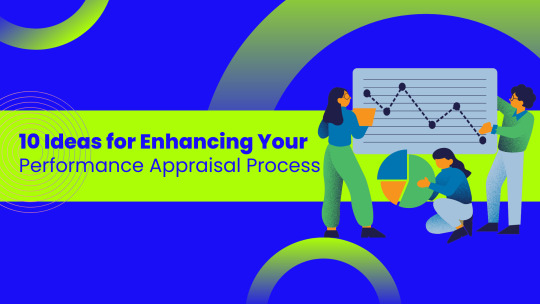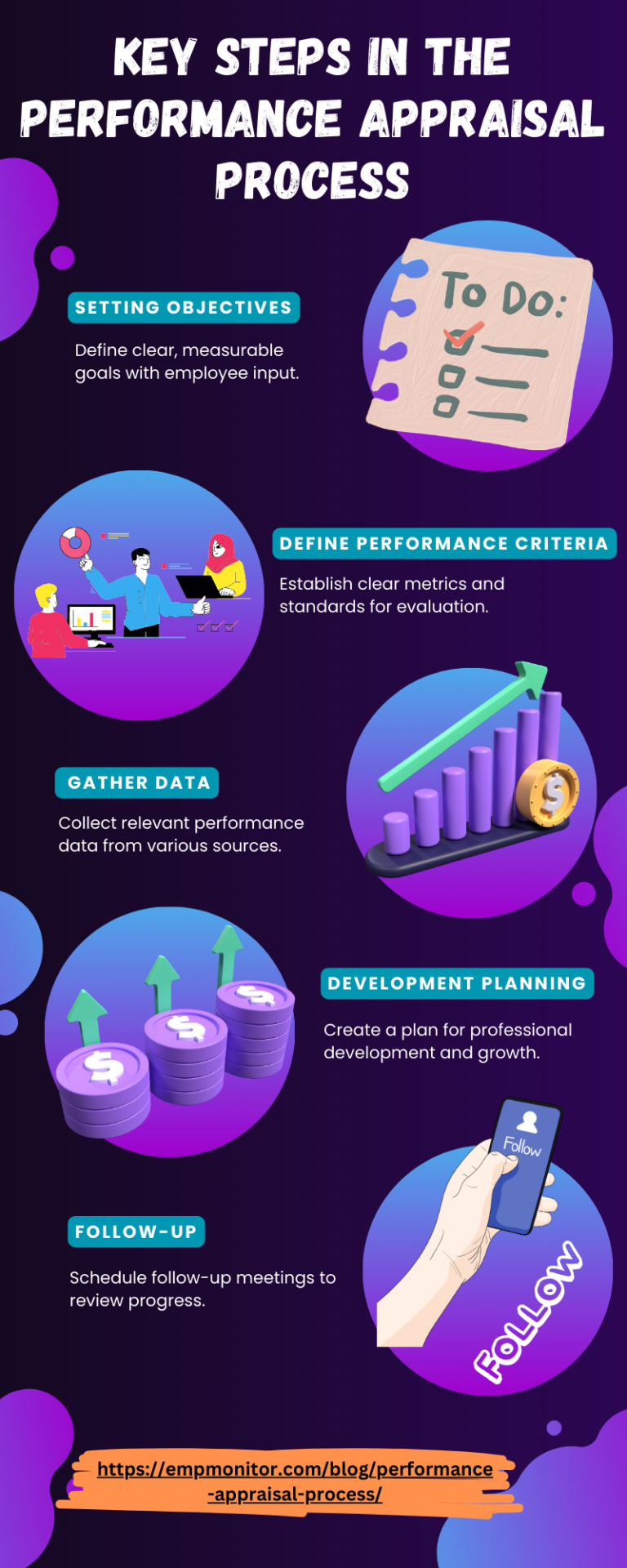#employee appraisal
Explore tagged Tumblr posts
Text
10 Ideas for Enhancing Your Performance Appraisal Process

In today’s fast-paced work environment, traditional performance appraisals often feel like a relic of the past—something to check off a list rather than a genuine opportunity for growth and connection. Employees want rapid, constructive, and engaging feedback, and businesses are increasingly recognizing the importance of nurturing talent to achieve success.
Consider a performance appraisal process that does more than just assess past performance; it actively promotes employee development, fires motivation, and deepens the link between managers and their teams.
In this blog, We will explore ten innovative ideas for enhancing your performance appraisal. These strategies aim to create a more meaningful dialogue, inspire professional growth, and ultimately contribute to a more engaged and productive workforce.
#1 Set Clear Expectations
Before the appraisal process begins, ensure that employees understand what is expected of them. Clear performance goals and criteria should be presented at the beginning of the review period. This transparency helps employees align their work with the company’s objectives, making the appraisal more relevant and constructive.
#2 Incorporate 360-Degree Feedback

360-degree feedback offers a more complete picture of an employee's performance. This strategy involves receiving feedback from a variety of sources, including peers, subordinates, and superiors. By collecting diverse perspectives, you can help employees gain a better understanding of their strengths and areas for improvement.
#3 Embrace Continuous Feedback
Move away from the annual review model and toward continual feedback. This approach encourages regular check-ins throughout the year, allowing managers and employees to discuss performance in real time. Frequent feedback can help address issues as they arise and foster a culture of open communication, reducing anxiety around formal appraisal meetings.
#4 Use Performance Management Software
Investing in performance management software can streamline the appraisal process. These tools often include features for setting goals, tracking progress, and facilitating feedback. With intuitive dashboards and analytics, both managers and employees can easily access performance data, making discussions more productive and focused.
#5 Focus on Employee Development

Shift the focus of appraisals from merely assessing past performance to emphasizing employee development. Appraisals can be used to identify growth areas and establish individualized development plans. Encouraging employees to pursue professional growth can boost engagement and retention rates.
#6 Make It a Two-Way Conversation
Encourage a two-way dialogue during the appraisal process. Instead of a one-sided review, create space for employees to express their thoughts, concerns, and aspirations. This collaborative approach not only builds trust but also allows managers to understand their employees' perspectives.
#7 Recognize and Reward Achievements
Incorporate recognition and rewards into your appraisal process. Recognizing an employee's accomplishments can increase morale and motivation. Consider implementing a structured reward system that aligns with performance monitoring outcomes, whether through bonuses, promotions, or public recognition.
#8 Utilize Goal-Setting Frameworks

Consider implementing goal-setting frameworks such as SMART (Specific, Measurable, Achievable, Relevant, Time-bound) or OKRs (Objectives and Key Results). These frameworks can provide clarity and direction, ensuring managers and employees are aligned on performance expectations.
#9 Offer Training for Managers
Train managers on effective appraisal techniques to ensure they provide constructive and actionable feedback. Training can cover active listening, delivering difficult messages, and setting SMART goals. Empowered managers are better equipped to support their teams through the appraisal process.
#10 Solicit Employee Feedback on the Process
Lastly, gather feedback from employees about the performance review process itself. Understanding their experiences and perspectives can provide valuable insights into what works and needs improvement. Use surveys or focus groups to collect input and be open to making adjustments based on their suggestions.
Also, watch this video - EmpMonitor | Leading Employee Engagement and Workforce Productivity Tool
youtube
Conclusion
Enhancing your performance appraisal system is essential for fostering a productive and engaged workforce. By implementing these ten ideas, you can create a more effective and supportive appraisal system that benefits employees and the organization. Remember, the goal of performance appraisals should not only be to assess performance but to inspire growth, development, and a culture of continuous improvement.
#performance appraisal#employee monitoring#appraisal system#360 degree appraisal#employee appraisal#Youtube
0 notes
Text

The Life Cycles of a Ranae Ebrius (Specifically Subject Epsilon aka Frogsilon)


Mat's got in undoubtedly bad (A crippling TBI courtesy of getting his head crushed by a Thumper + Lasso-Manification due to exposure to the Company Monster is not a great hand to be dealt), but at the very least he still has his sanity... The Lone Survivor on the other hand...

What the dog doin'?
#Eps Draws:#Lethal Company#Lethal Company OCs#Employee OC#Frogsilon#Mat the Inventory Appraiser#The Lone Survivor#Leon the Corpse Retriever#Eyeless Dog#Lasso Man
10 notes
·
View notes
Text
When I defend someone only for them to reveal they don't care whether I live or die

#lotta drama happening at work right now over an appraiser i dont even like#i always thought she was arrogant but at least smart and capable#but shes basically decided to openly jeapordize all of the other employees in part because shes salty that i am not just her assistant#and cannot drop everything at a moments notice to help her with stuff#hopefully she'll get her head screwed on straight after being locked out of the computers for a few days#happy eclipse everyone
2 notes
·
View notes
Text

Streamline Employee Appraisals with HR Software Bahrain
Upgrade your HR functions with top-tier HR payroll software in Bahrain. Our solution offers an employee appraisal system, comprehensive performance management tools, secure employee records management, and a hassle-free leave management system, making HR management easier and more efficient.
#hr & payroll software#hr payroll software#hr software pricing#employee training software#travel management#software#Employee Offboarding Software#core hr software#HR Reporting Software#Employee management software#payroll#hr payroll software bahrain#employee appraisal system#performance management system#employee records#management#leave management system#leave tracking software#asset management system#asset management software#attendance management software#employee attendance software#time and attendance software#Onboarding software#Cloud HR#Software#hiring software#hr software in bahrain#talent acquisition software#HR Onboarding
0 notes
Text






Performance review season—where dreams of a big raise meet the cold, hard reality of corporate budgets. Which one are you? Drop your type in the comments!
1 note
·
View note
Text
Affordable Employee Appraisal System to Meet Your Performance Goals

The value of performance appraisal and management in your organization covers an important aspect of employee engagement activities. It could open up your functions and attributes to get optimum results in the domain of employee performance management. This post involves some of the best practices in the organization’s operations approach to create or develop an empowering and engaging HR performance model. You can work on this domain easily with the active assistance and guidance of a proven and dedicated employee appraisal system model.
Employee Appraisal System Features for Boosting Performance
Certain functional benefits and perks are available for your business model when you work with an exclusive and unique employee performance management system. The major features that can help you in this regard can be listed below:
Automated reviews
One of the ideal features for you to consider in a model that discusses automation solutions for employee performance assistance is the review management model. You should use a performance management system that can help produce some of the top-notch solutions in review and feedback support for your firm.
Authentic goal-setting
An important feature that could help you grow in the HR operations corresponding to employee performance management is the supportive role offered by a goal-setting projection. This objective can give you optimum support to meet your appraisal and feedback requirements.
Continuous and flexible feedback
Performance appraisal and support gives way to the creation of an optimized HR management model that helps develop core feedback functions and continuous operations processes. It helps you in the adoption of HR management policies and support system integrations.
Software integration support
When you go for streamlined and seamless integration values in the HR operations domain, it could be connected well to employee performance measurement and support. You can track and analyze this feature with a promising employee records management platform.
Performance recognition and rewards
The category of employee rewards and recognition is directly connected to the performance and appraisal system activities. It could be beneficial for your organization’s bigger picture support and services.
Considering the scope and potential of HR management solutions or services in the performance domain, efficient tackling of custom support is needed to boost the entire model. When you work with an integrated employee appraisal system to get the best benefits in the niche, it opens up a whole host of opportunities to build value to your core HR management system attributes.
0 notes
Text

Connect with us to learn how Appraisal Management Software can help organizations adapt to remote and hybrid work environments. We can help you use the software in less time and with fewer steps. Call our Expert @ 9999143778.
#appraisal management software#appraisal management system#appraisal management company#employee performance management#employee appraisal management#performance feedback software#automated performance reviews#performance management tool
0 notes
Text
Key Steps in the Performance Appraisal Process
This infographic is a crucial resource for businesses and HR professionals seeking to enhance their performance appraisal process.

#performance appraisal process#performance appraisal#employee monitoring#performance appraisal system#360 degree performance appraisal
0 notes
Text
POV: Appraisal Meeting with Your Manager
#employee#manager#appraisal#creator#memes#meme#corporate#corporateworld#corporatememe#corporatememes#memesdaily#viralmemes#memeoftheday#swapnilkadam
0 notes
Text
Understanding the importance of performance appraisal is essential for business owners and managers. Learn how it can drive employee performance and organizational success
0 notes
Text
#The Future of Performance Reviews#performance management trends 2024#latest performance management trends#new performance management trends#employee performance management trends#performance management trend analysis#trends in performance management and feedback#current issues and trends in performance management#performance management current trends#changing trends in performance management#emerging trends in performance management#performance management future trends#global performance management process#hr trends performance management#top trends in performance management#key trends of performance management#latest trends in performance management system#performance management new trends#performance appraisal new trends#trends of performance management#2024 performance management trends#hrprocess#humanresourcemanagement#humanresource#hr#hrm#future of work
0 notes
Text
As the calendar turns and the year progresses, organizations worldwide gear up for a significant event in the corporate calendar - appraisal time. For managers, this period represents not only a time to assess individual performance but also an opportunity to strengthen the very foundation of their teams. In this article, we delve into the importance of appraisal time for managers, focusing on how they can leverage this period to foster team cohesion, motivation, and productivity.
1 note
·
View note
Text
#360-degree feedback#behaviourally anchored rating scales#being objective and fair#communication#comparative performance evaluation#critical incident technique#documentation#documenting everything#employee development#employee evaluation#encouraging self-assessment#feedback#focusing on behavior and results#focusing on growth and development#follow up#forced distribution#Goal setting#graphic rating scales#job performance#JobsBuster blog#management by objectives#mastering performance appraisal#narrative appraisals#organizational success.#performance appraisal#performance appraisal methods#performance review#preparing thoroughly#productivity#providing regular feedback
0 notes
Text
Employee Appraisal & HR Software Bahrain - Simplified
Our HR payroll software in Bahrain is packed with features like employee appraisal system, performance management system, employee records management, and leave management system to streamline your HR tasks and improve organizational performance.
#hr & payroll software#hr payroll software#hr software pricing#employee training software#travel management software#Employee Offboarding Software#core hr software#HR Reporting Software#Employee management software#payroll software#hr payroll software bahrain#employee appraisal system#performance management system#employee records management#leave management system#leave tracking software#asset management system#asset management software#attendance management software#employee attendance software#time and attendance software#Onboarding software#Cloud HR Software#hiring software#hr software in bahrain#talent acquisition software#HR Onboarding#best cloud hr software#HR Software#hr software systems
0 notes
Text
The Evolution of Performance Reviews: From Annual Appraisals to Continuous Feedback
A Look Back at Traditional Performance Reviews For decades, the annual performance review has been a cornerstone of corporate culture. Traditionally, this process involved a once-a-year meeting between an employee and their manager to discuss performance, set goals, and possibly discuss a salary increase or promotion. This method, rooted in the industrial age’s hierarchical and regimented work…

View On WordPress
#360-degree feedback#annual appraisals#bidirectional feedback#continuous feedback#Employee engagement#organizational culture#performance management technology#performance reviews#real-time feedback#workplace innovation
1 note
·
View note
Text
What Are the Unbelievably Good Uses of Employee Appraisal System?

When you have a promising HR management system that can raise the value of various operational parameters, it could benefit your organization in the long run. The importance of an employee appraisal system cannot be underestimated because it could provide substantial benefits to your overall HR objectives. This post deals with the management of employee appraisal model programs with the efficient support of an authentic and well-versed HR management system.
Best Uses of An Employee Appraisal System
When we talk about the optimum values and parameters that can help you evolve in the HR operations management model, it could offer genuine assistance from the viewpoint of formulaic HR functions. The mainstream functions and use cases that support your cause in the adoption of employee appraisal terms can be described as follows:
Creativity and innovationIf you can boost the functions of creativity and innovation in a defined HR operations model, it could be placed to support your core employee performance and appraisal goals. A layered performance management system is sufficient to get optimum support in your custom inclusion of various operations management possibilities.
Teamwork and collaborationYou can get essential HR management support in the domain activities that can help you with features of teamwork and collaboration. It could also possibly help you attain valuable support in carrying out employee performance and appraisal programs.
Attendance and time managementWhen you have a time and attendance management system or model, it could feasibly promote your evaluation of employee performance appraisal and core business productivity measurements. You can work with employee records management processes to get active assistance in this domain.
Communication and problem-solving skillsThe processes and principles associated with the core features of communication and problem-solving can be attributed to providing value and focus to your employee appraisal system processes.
Work ethic and attitudeThe promising support offered to the factors of work ethic and attitude can provide unique and essential value to boost your employee appreciation programs. This use case can adapt well to any scenario of HR operations management.
When you have a dedicated and proven employee appraisal system, it can raise the entire HR workflow operations and processes that can aid your business model activities. Customized evaluation of employee performance and corresponding appraisal service is a key parameter that can raise the value of your core HRMS platform integrations and functions with effective ease.
0 notes